This post was planned for the occasion of Egypt’s National Day aka 23 July Coup/Revolution/Movement “Whatever you prefer” as Kodak Agfa would like to share with you those couple of photos taken in summer 2019 but time was not that friendly.
It ended up posted a month later!!
If you are into bizarre-stuff-niche museums with a little dark twist, then you will like this post.
If you are into hunting and animal taxidermy, then this is your place.
 |
| Gazelles shoulder mount taxidermy at the Royal taxidermy |
This post is about the Mohamed Ali Taxidermy and Hunting Museum or as officially known “Royal Hunting Museum”.
This place is in the Prince Mohamed Ali Tawfik Estate at Cairo’s Al-Manial island which I visited with a group of friends in August 2019.
We already visited its beautiful small mosque and saw how much the eccentric prince who could have been a king was influenced by Islamic architecture especially in Andalusia.
Our next stop in this big estate that looks like a small oasis inside the buzzing Cairo is the Royal Hunting Museum or Mohamed Ali taxidermy museum. “I hope its trees survive the trees massacre still going on across the country”
 |
| Water Buffaloe's shoulder mount taxidermy and goose taxidermy at the Royal taxidermy museum |
First, I apologize for the bad photography as the lighting in the Museum is not camera friendly. There are out of focus photos too.
I thought at first this is the personal collection of Prince Mohamed Ali Tawfik and that building where he used to taxidermize those poor animals he hunted and collected.
This made me think that he would be more eccentric than he was already.
But I was mistaken.
That small building located near the mosque did not exist before the 1960s. It was not part of the original buildings in the estate, nor it was commissioned by Prince Mohamed Ali Tawfik.
It is obvious when I think about it as it lacked that artistic spirit that exists in other buildings.
The Royal Hunting Museum was built in the 1960s after the estate was nationalized. It was built to accommodate a huge collection of taxidermies collection owned by Mohamed Ali Royal Family.
 |
| African elephant's tusks and foot at Royal Taxidermy Museum |
It hosts exactly 1130 animal and bird taxidermies and skeletons that were once owned specifically by two of the Egyptian Royal Family members: King Farouk I and Prince Youssef Kamal according to official information.
It made sense when I found that Ostrich egg with Farouk and his first wife Queen Farida’s faces on it as a young couple from the year 1938 when they got married.
 |
| The Egg with Farouk and Farida's faces |
Prince Mohamed Ali would not have simply had it because he hated King Farouk so much and believed the throne was his birthright.
The man had his own Throne Hall in the estate. “Wait for a post about it”
I think most of the things in the museum belonged to late Prince Youssef Kamal’s original collection that he had donated to the Agricultural Museum decades ago before the 1952 coup.
King Farouk used to go on hunting and fishing trips across Egypt, but he was not a real and professional hunter like Prince Youssef Kamel.
 |
| Young Farouk as a hunter, this photo was there in the museum "Farouk Misr" |
Farouk did not travel across the borders for hunting in his reign as Kamel in the first place as far as I know. We got many animals that were hunted abroad whether in Africa or Asia.
One of Modern Egypt’s top explorers and travellers in the 20th century, Prince Youssef Kamel went on hunting trips in Asia, Africa and Europe.
 |
| Very old and tired African lion taxidermy I would say |
Prince Youssef Kamel is one of my favourite figures in pre-1952 coup Egypt in general as well as in the Egyptian Royal Family.
The prince was considered the richest man in Egypt in the 1940s with wealth equal to LE 10 million from agricultural land, palaces, properties, art and antiquities collections.
He also left several amazing palaces, marvels in their architecture alone that were turned into museums in their own way.
 |
| A Wild Boar Shoulder Mount Taxidermy |
By The way, recently I found out the locals found special train cars, more of a suite owned by Prince Youssef Kamel which he used in Luxor.
I think we must restore those special train cars and include them in the Royal Carts Museum collection or the Egyptian Railways Museum.
Anyhow back to our Royal Taxidermy Museum.
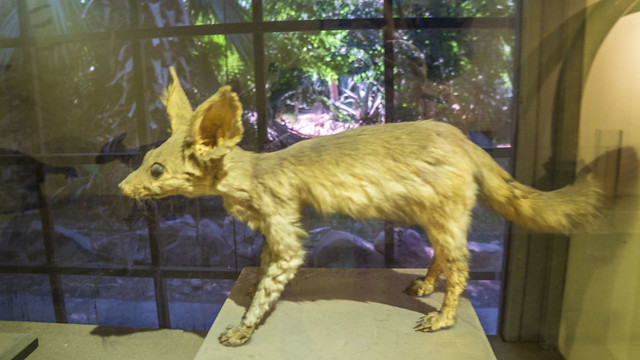 |
| Egyptian Fennec Fox |
The Royal Hunting Museum was inaugurated in front of the public in 1963.
It is one of the very small unknown museums in Cairo. In 2006 it was closed for restoration that took a whole decade.
It was inaugurated for the public in 2017.
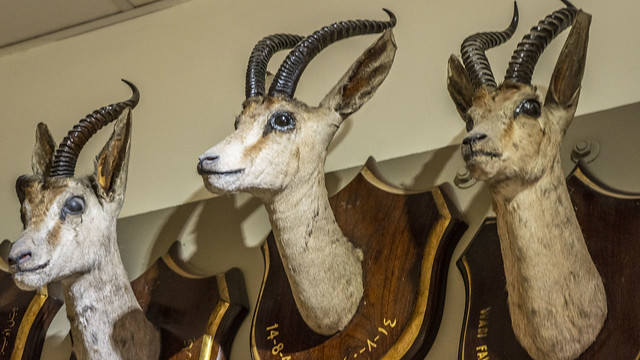 |
| Gazelles shoulder mount taxidermy |
The museum includes a huge collection of all sorts of animals, birds, insects as well as marine creatures too.
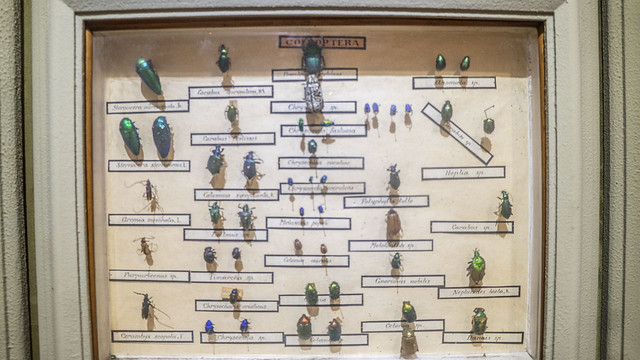 |
| Beetles taxidermy box |
The labels here were written in English or rather Latin.
The shoulder mount taxidermies had the dates of their hunting written in Arabic and English. I noticed that many of those animals were hunted in the 1940s.
 |
| A Capra hircus goat shoulder mount taxidermy |
Also, I can’t ignore how beautiful that Arabic cursive font is.
There is a skeleton of one of the camels that were used to lead the procession of El-Mahmal or the Great Ceremony of the Holy Carpet.
Egypt had celebrated for centuries El-Mahmal in a huge procession led by El-Mahmal camel since Middle ages till the Nasser Era when it was topped due to the tension with Saudi Arabia
 |
| The camel's skeleton and pay attention above there is a camel head too |
 |
| The camel while carrying the Mahmal circa The 1930s-1940s "Khalili collection |
According to my Grandma who saw that ceremony live, one of the strongest and beautiful camels were chosen from the Birqash Camel Market to have the honour of carrying the Holy Cloth to the Kabaa in Mecca.
You can a camel shoulder taxidermy above the skeleton if you focus and it looks as if it is smiling awkwardly.
After choosing the camel, it was kept at Abedin Palace where it received extra care for its big duty. They also received extra training a week before the procession on lifting and walking with heavy loads equal to the Holy cloth.
 |
| An old article showing how the camel is trained and how much the camel cost "about LE 342" |
Thus, I believe that skeleton from King Farouk’s collection.
There are also several hunting maps issued by the Egyptian government.
 |
| The-1962-hunting map of Egypt at the Museum |
One of those maps that meets you when you enter the museum is “Egypt’s Hunting Zone” which goes back to the 1960s.
It was hand-drawn in 1962 by a cartographer called Khaled and it is considered the latest map in the museum.
The map listed the animals for hunters unfortunately according to location during its time.
There were 13 unique animals in Egypt then available for hunting and they were: Egyptian gazelle, fox, crocodiles, hare, procaviasp, hyena, white gazelle ibex, tiger, leopard, wild ass, wild sheep and addax.
Some of those animals are already extinct in Egypt to the level that I did not know that they existed at all like tigers.
 |
| The Arabian Leopard at the Museum |
The Arabian leopard still exists but it is endangered already due to illegal hunting activities like that one that took place in 2016 and killed that animal that was seen in the area for decades.
Wild cats are also native to Egypt.
 |
| A wild Cat at the Museum |
Do not know if that wild cat was hunted in Egypt or not.
Already with further reading, I found out that we had even more interesting animals like lions that were extinct locally for a long time before the time of Mohamed Ali Pasha and his dynasty due to hunting.
It makes sense as ancient Egyptians worshipped a lioness aka Sekhmet.
There are other local animals like the Egyptian Mongoose which still lives in Egypt and unfortunately, it is hunted and is traded mostly illegally too.
 |
| Egyptian Mongoose |
I found this video for an Egyptian mongoose raised by some wild animal trader in Egypt. Its voice is sad in captivity, and you can see that it eats snakes.
According to a news report in Al Ahram Arabic Portal in 2019, the demand for Egyptian mongoose was on the rise because it gets rid of mice and snakes yet is friendly. The price of the mongoose then was between LE 3,000 to 5000!!
Here is a little small gazelle fawn whom I feel sorry for along with another small animal I could not identify.
 |
| A small Gazelle Fawn with another little animal |
 |
| Our flag's Eagle in the Museum |
There are also a group of hawks too.
 |
| Eagles in the Museum |
And very nice owls that seem to be smiling.
 |
| Owls in the Museum |
They are not from the Pharaoh Eagle-owl family but seemed to be close to famous Egypt’s little owl “Um Uway’e”. Birds expert can help us.
There are also domestic birds’ taxidermies in the museum.
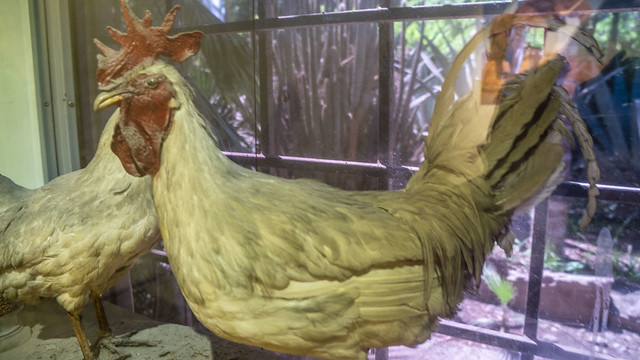 |
| Hans in the museum |
There is a pelican that can be identified easily if its true colour is restored.
 |
| Once a pelican, you can see a crocodile behind it |
I think this is a stork but its peak did not survive time.
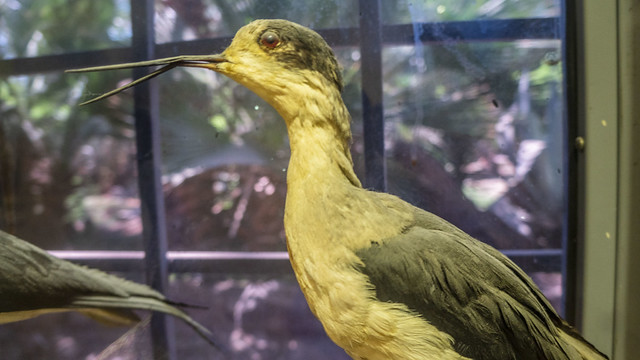 |
| A stork ?? |
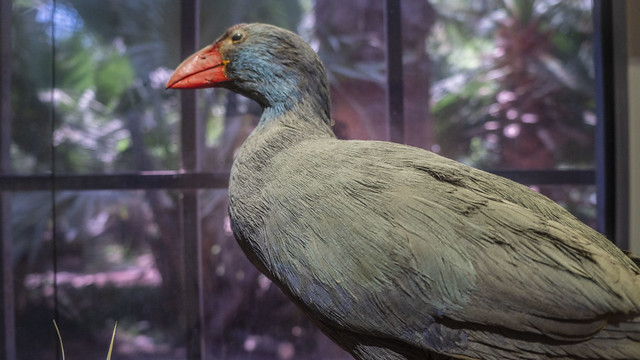 |
| A beautiful African Swamphen |
Its colours are amazing and it turned to be native in Egypt but its numbers are declining. I hope one day I meet it while it is alive and free.
Also, those two birds are too exotic.
 |
| The unique Golden pheasant and Lady Amherst's pheasant |
Their names are exotic too: Golden pheasant and Lady Amherst's pheasant. Their colours, while they are alive, are amazing.
There are also interesting and beautiful birds made up in some sort of mock-up or a scenery set up and those two collections are from my favourite pieces in this museum.
 |
| You can spot the hoopoes |
You can see hoopoes and other birds too. Hoopoes are natives of Egypt.
 |
| A beautiful arrangement |
I believe they are from Prince Youssef Kamal collection.
There is a skin of an African rock python aka Python Sebae which I am glad that it is not native to Egypt.
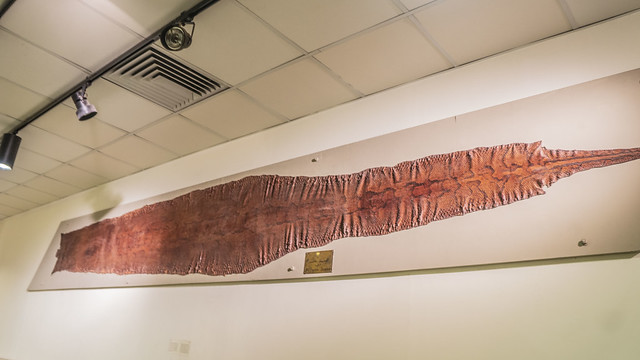 |
| The python's skin, see how long it was |
There is strange stuff in the museum-like that female small goat that was produced from some abnormal goat that came from Yemen’s Kamaran island.
 |
| That small goat from Kamaran island |
There is also a hedgehog in the same display. I do not know from where that hedgehog came but Egypt has got hedgehogs according to my limited info on our wildlife.
In ancient Egypt, there was a little-known deity called Abaset depicted as a hedgehog.
FYI, Yemen’s Kamaran is a beautiful small island that did not survive the civil/regional proxy war there, it is surrounded by naval mines reportedly implanted by Iranian-backed Houthi militias.
There are sea creatures there too including those giant crustaceans.
 |
| A lobster at the Museum |
King lobster or just lobster, I do not know but to keep its colour till this day it is impressive despite not all its claws or antennas are intact after all those years as you see.
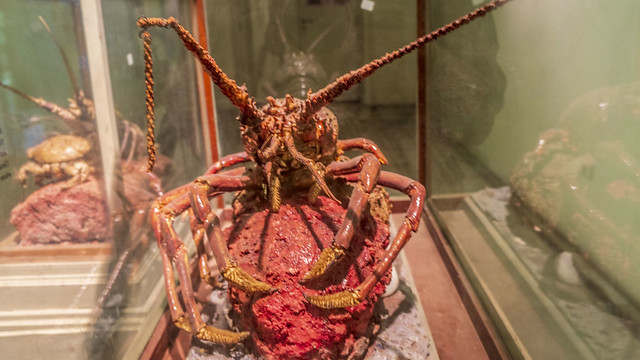 |
| One of the antennas unfortunately was broken |
I believe this lobster can be from King Farouk’s collection as he made several famous red sea trips and he met in one of them young oceanographer then Dr Hamed Gohar and visited his centre that turned into a museum currently in Hurghada.
 |
| King Farouk in his visit to the famous and unique Dr Hamed Gohar's Red Sea marine centre and museum |
There are also collections of rare butterflies with their names and their colours are still amazing.
 |
| Colourful butterflies |
Their names were written in English and in one box the names were handwritten while in the other box the names were written on a typewriter interestingly.
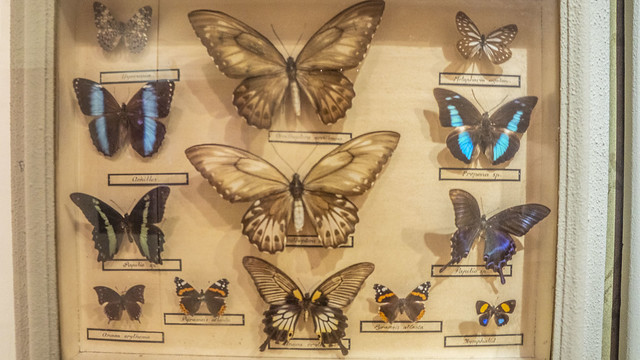 |
| More Colorful butterflies |
They came from every size, shape and colour. I wonder which types were native to Egypt.
 |
| And more colourful butterflies, one is down though |
I must say this visit made m read more and search more about animals and birds, which is great actually if you think about it.
This is how a small museum can do a bigger change in society by preserving the historical and natural heritage of the world not only your country.
 |
| A sweet little coloured bird did not catch its name |
Video is not allowed unfortunately in the museum nor in the rest of the estate for reasons I ignore.
The museum officials can charge extra fees for non-commercial filming like in the Egyptian Museum of Cairo for instance.
Someone like would be more willing to pay as those extra fees can be used to look after the wonderful place.
 |
| A wild cat with a rodent at the Museum |
The Museum can be improved a lot.
I looked up online and found out that already we can clean those animals taxidermies and make them look new using special materials and special detergents.
I want to drag myself to visit this beautiful place again, but I am so worried that its trees did not survive the ongoing trees massacres taking place in Cairo for reasons beyond us to understand.
I used in this Kodak Agfa’s visit a Sony Alpha 6500 with Sony Alpha SEL1855 E-mount 18-55mm

No comments:
Post a Comment
Thank You for your comment
Please keep it civilized here, racist and hateful comments are not accepted
The Comments in this blog with exclusion of the blog's owner does not represent the views of the blog's owner.